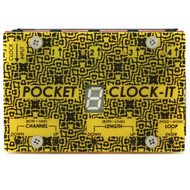Pocket Clock-It - Moffenzeef Modular
by Sam Chittenden
Moffenzeef Modular's Pocket Clock-It is a credit-card-sized random gate sequencer and clock divider measuring about 3" by 2", and quarter-inch thick. It’s bright yellow with a pattern like somebody spewed QR codes all over it and it looks a bit like one of those pagers that restaurants hand out to let you know when your table is ready. Made of two PCB boards sandwiching a handful of components, the unit feels well constructed and sturdy; definitely pocket worthy. It even comes in a handy little reusable plastic box.
On the front is a 7-segment LCD display paired with five tiny buttons. These are grouped under labels for CHANNEL [DOWN and UP], LENGTH [DOWN and UP], and LOOP [ENTER]. Along the top edge is a 3.5mm CLOCK input jack and four gate channel outputs numbered 1-4. Power is supplied via a USB micro-A port on the right hand side of the unit. Though the Pocket Clock-It comes with a USB cable, it's super short; however, at this point most of us have enough USB cables hanging around that it isn't a big deal, but it is something to be aware of in any case. Other than 400ma from the USB the only thing needed is to feed the the Pocket Clock-It a clock signal. Anything over a 1/2 volt will do and I had success feeding it a few different signals, although the closer you get to a square wave the more stable the clock is—especially at higher clock rates. Once you are powered and clocked, the Pocket Clock-It can operate in one of two different modes: either as a random—but loop-able—gate generator, or a programmable clock divider. Both modes feature 4-channels of output [a 5v trigger] and each output jack has an LED that flashes along with its output signal, which is great for visual feedback. While it has two operating modes there is no mixing of modes, so you can't have 2 channels of gate sequencing and 2 channels of division.
In random mode the Pocket Clock-It will generate a different random gate sequence at each of its outputs. Each channel's sequence length can be edited individually or you can affect all channels at once, and changing channel parameters is easy and intuitive. Choose which channel you'd like to edit by pressing the CHANNEL UP or DOWN button. The selected channel will be indicated on the LCD [1, 2, 3, 4, or "A" for all]. You can set the length of the sequence using the LENGTH UP or DOWN buttons and each channel can have a different length [from 1 to 8 steps] and can be looped. You toggle the looping by pressing LOOP [looping is indicated by a solid decimal on the LCD] individually [or all at once].
Clock division mode operates in the same manner as random but the LENGTH buttons adjust the rate of division [/1, /2, /3, and so on]. I wanted to see if the Pocket Clock-It could work as a subharmonic generator as you can push the clock input well up into audio rate but the divided outputs don't really work for audio generation as the sound gets pretty choppy and distorted.
In both random and clock division mode you can save up to 8 presets [8 slots for saved gate sequences and 8 for clock division] in the onboard memory and saving and loading presets is a snap, and refreshingly indicated on the face of the unit. To save you just press both CHANNEL buttons at the same time then using the CHANNEL UP or DOWN buttons you select a memory slot and press the LOOP [ENTER] button. Loading presets follows the same process but using the LENGTH buttons. Presets are loaded along with the next incoming clock pulse, making it easy to keep your rhythms synchronized when changing between presets.
When I first pulled the Pocket Clock-It out of its case I was a bit skeptical, but it has proven to be a ton of fun to play around with and I found it excellent for jamming. Playing around with different sequence lengths is a blast and because each channel can have independent amounts of steps you can get some quite complex rhythms happening really easily. The Pocket Clock-It is also a great tool for driving sequencers with irregular clocks, triggering envelopes in rhythmically interesting ways, or messing with clocked delay modules. As a handy utility it's hard to beat, especially if you are short on rack space. The straightforward controls and nice visual feedback make the Pocket Clock-It super jam-able and really useful as a rhythmic idea generator and its ease of use and well thought out controls also ensure that if it stays in your pocket for too long you won't have to re-remember how to use it. And that is no small thing.
Price: $125


